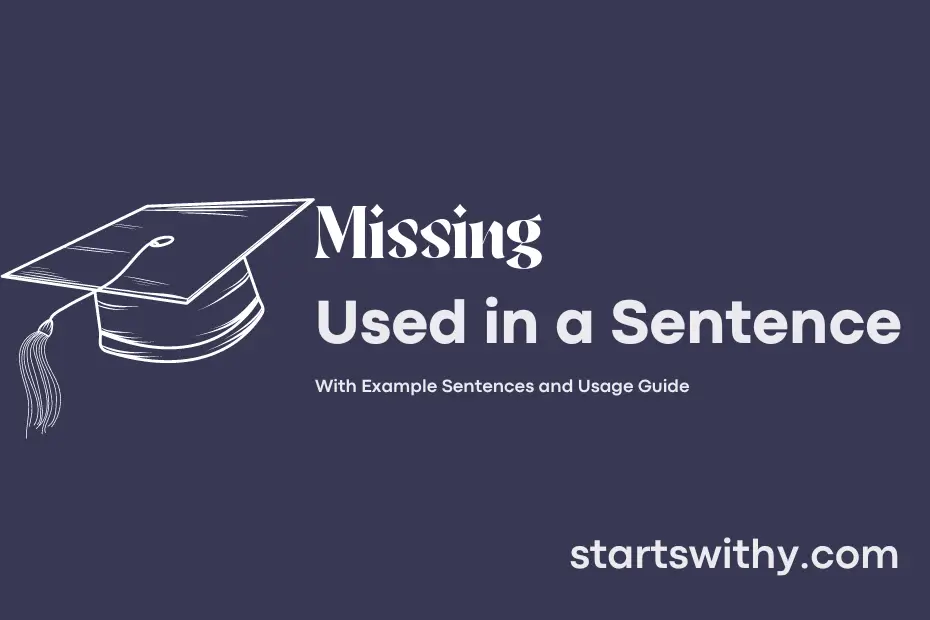Have you ever wondered how a sentence can be incomplete or confusing because a crucial element is not included? This is known as a “missing” element in a sentence, which can disrupt the flow and clarity of the communication.
When a sentence has a missing subject, object, verb, or other essential component, it creates a gap in the information being conveyed. By identifying and addressing these missing elements, writers can ensure their sentences are complete and easily understood.
7 Examples Of Missing Used In a Sentence For Kids
- The puzzle is incomplete, a piece is missing.
- Let’s find the missing sock in the laundry.
- Uh-oh, my favorite toy is missing.
- Can you help me locate the missing book?
- The cat went out and now it’s missing.
- Look carefully, the last letter is missing from the word.
- There is a missing number in the counting sequence.
14 Sentences with Missing Examples
- The student realized they were missing their textbook just before the exam.
- After searching through their bag, they found their notes, but their pen was missing.
- The group project presentation was incomplete because one member was missing.
- The professor reminded the class about the deadline for the assignment and stressed the consequences of missing it.
- The student felt anxious as they scrolled through the syllabus, realizing they were missing a crucial chapter.
- The student’s attendance record showed they were missing classes frequently, which affected their grades.
- The upcoming campus event was highly anticipated, but many students were upset that their invitations went missing.
- The deadline for submitting internship applications was approaching, and a vital document was missing from the student’s file.
- The student hurried to the library to print their assignment, only to discover that one page was missing from the printer tray.
- The campus bookstore had a sale on textbooks, but the student was disappointed to find that their required textbook was missing from the shelves.
- The student checked their email anxiously, hoping to receive a response from the professor regarding the missing assignment submission.
- The student rushed to the bus stop, fearing they were missing the last shuttle back to campus.
- The student received a notification about missing important seminars that were mandatory for their degree program.
- The student realized they left their ID card in the hostel room and feared missing out on attending the college event.
How To Use Missing in Sentences?
Missing is used in a sentence when something or someone is not present or cannot be found. To use Missing correctly, follow these guidelines:
-
Identify what is not present: Determine what is Missing in the sentence. It could be a person, an object, a piece of information, or an action.
-
Choose the appropriate verb tense: Use the verb “is” or “was” with Missing to indicate the current or past absence. For example, “My keys are Missing” or “The report was Missing yesterday.”
-
Provide context: Explain why the item is Missing by providing additional information in the sentence. For instance, “The book is Missing from the shelf” or “She is Missing because she is sick.”
-
Use it in a sentence: Incorporate Missing into a sentence by placing it before the subject or object that is not present. For example, “The cat is Missing” or “The letter is Missing.”
-
Check for clarity: Ensure that your sentence using Missing clearly conveys the absence of something or someone. Revise if needed for better understanding.
By following these steps, you can effectively incorporate Missing into your sentences to communicate when something is not present or cannot be found. Practice using Missing in various contexts to become more familiar with its usage.
Conclusion
In conclusion, sentences with missing words, phrases, or punctuation can lead to confusion and misinterpretation in written communication. It is crucial to ensure that sentences are complete and coherent to convey the intended meaning effectively. Missing elements can disrupt the flow of information and hinder comprehension for readers, causing them to fill in the gaps or make incorrect assumptions.
By being mindful of sentence structure and ensuring all necessary components are present, writers can enhance the clarity and readability of their text. Taking the time to review and revise sentences with missing elements can greatly improve the overall quality of written communication, allowing for more accurate and effective message delivery.



